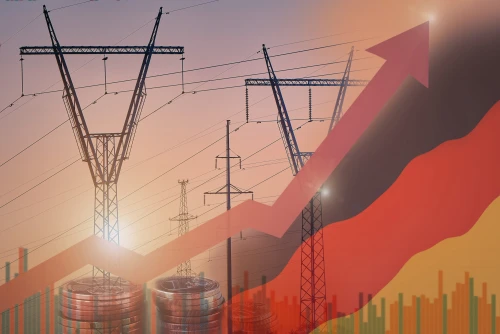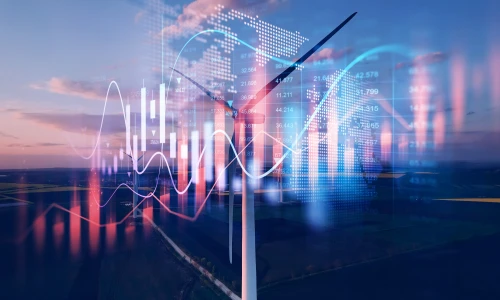
April 24th, 2025
Join our Italian Energy Day on 20 May – Book now
PPAs are increasing in popularity as businesses are realising the benefits of buying energy at a fixed price, meaning they can manage stable electricity costs over a longer period. But due to the complex nature of PPA agreements, different pricing models have been created to help manage risk and expectations between the energy buyer and energy seller.

It’s important that before you look at entering a PPA agreement, you consider all pricing options and ensure you’re well informed so that you can chose a pricing model that reflects your financial position, your business’ sustainability goals and the level of risk you and your lender are willing to take. Below we’ll take a look at the various pricing options available to PPA contract holders.
Fixed price PPAs are the most popular choice for PPA agreements. A fixed price is agreed between the energy seller and energy buyer, which fixes a price over the length of the PPA agreement. In recent times popularity has shifted as energy prices increase, making a fixed price PPA a less desirable option as prices continue to vary.
Built with more flexibility in mind, floating PPAs allow pricing to go up and down with market energy prices. Much like a residential energy contract, prices can rise or fall - if they fall, cost savings can be made, but if they fall, the overall risk can be higher. Elements like the predefined index or market volatility tends to affect these types of PPA contracts.
Less common than fixed price PPAs or floating PPAs, hybrid price PPAs allow even more flexibility in pricing than floating PPAs. A hybrid price PPA allows you to combine different types of energy pricing to suit your business, meaning you can procure some energy at a fixed price and some at a variable price. This is beneficial because it allows you to have a stable element of your billing, with a concurrent element that can go up or down with market conditions.
A PPA can also be combined with physical supply of electricity. This is different from a fixed or floating PPA which tends to procure renewable energy from one renewable energy plant. The physical supply service manages the generation of energy as well as the delivery to the energy buyer’s site. As well as renewable energy, a bundled price PPA can also include traditional methods such as gas, coal and nuclear.
A less risky take on a floating or hybrid price PPA, a market following price allows you to take advantage of volatility in the energy market, but sets a Floor Plus Discount. A Floor Plus Discount sets a floor price limit that will be the lowest you will pay. In addition to a Floor Plus Discount, you’ll often pay under market price for energy, known as a discount.
Fixed pricing PPAs allow for a more stable pricing system, which gives more freedom for accurate budgeting long-term. Floating, hybrid and market following pricing on the other hand are more uncertain - with the latter you may even end up paying more than market rate.
The least flexible of PPA contracts tends to be fixed PPAs and if energy prices drop, you won’t see the benefit. Hybrid PPAs offer much more flexibility meaning you can adapt to market volatility. Bundled PPAs also offer a more diversified choice, giving you the option to choose from a portfolio of different energy options.
Arguably all PPAs champion sustainability because they help businesses to invest in renewable energy sources and reduce carbon emissions. Fixed, floating, hybrid pricing PPAs in particular help businesses to achieve fixed sustainability goals as energy comes from purely renewable energy sources.
With bundled PPAs, your PPA and energy service supply is streamlined, making it easier to manage the organisational side of energy procurement. Alternatively, hybrid and market following PPAs can be complex to manage as you’ll be balancing various different pricing structures.
Hybrid PPAs, are influenced by outside factors such as market volatility or numerous energy sources, making it difficult to negotiate beneficial terms. Fixed price PPAs tend to take a long time and require expertise to negotiate.
If you’re intending on investing in a PPA in the future, it’s vital you draw up a pricing structure that best fits your business, so consider which is more crucial, for example price stability or the flexibility to move with market changes.
It would be fair to estimate that as businesses commit more rigidly to sustainability goals that the interest in PPAs will increase generally. But as pricing increases, there is a possibility that fixed price PPAs will dip in popularity, opening up the options of hybrid and floating as alternatives.
A long-term PPA between Orsted, a renewable energy provider and Northumbria Water, helped Northumbria Water achieve ambitious sustainability goals by fixing their energy costs with a renewable provider for 10 years.
Entering the PPA with Orsted means that Northumbria Water is now investing in:
Providing 100% renewable energy to all of their UK sites
One of the world’s largest wind farms based in Yorkshire, UK
Pioneering floating wind farms in Scotland with partners Simply Blue Energy and Subsea7
Orsted has transformed from one of the most coal-intensive energy producers in the UK
The ability to report Net Zero carbon emissions for the energy procured from Orsted
Achieving the sustainability goals that were originally set by Northumbria water
Looking for more guidance on PPAs?

April 24th, 2025

April 23rd, 2025

April 22nd, 2025